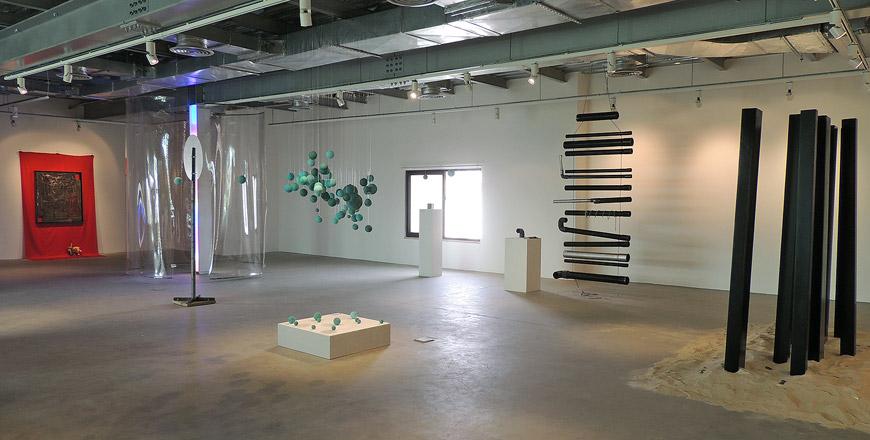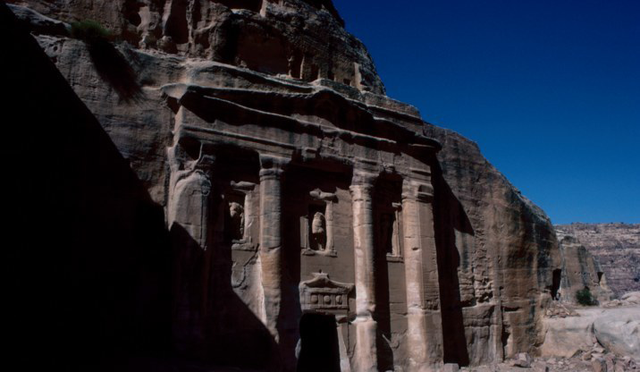You are here
Reflections of life, metascape and more
By Ica Wahbeh - May 01,2017 - Last updated at May 01,2017

Works on display at the Jordan National Gallery of Fine Arts through May 30 (Photo courtesy of the Jordan National Gallery of Fine Arts)
The Jordan National Gallery of Fine Arts is quite busy this spring. Three new exhibitions grace its halls, besides the permanent collection, and more is in store for art lovers who should not miss the chance of seeing works by “pioneering” Arab painters, photos of two foremost Mexican artists and surprising installations by young Jordanian artists.
From the works that form part of the collection of the Barjeel Art Foundation — the personal art collection of Sultan Sooud Al Qassemi, that wishes “to contribute to the intellectual development of the art scene in the Gulf region by building a prominent, publicly accessible art collection in the UAE” — exhibited on the ground floor, the viewer can draw delight and an idea of how the art scene evolved in the Arab world from the late 1880s.
Or, as curator of Barjeel Art Foundation Suheyla Takesh puts it, “notice the selected paintings not only reflect a socio-political condition of their time and individual preoccupations of their makers, but bear testimonies to the training the artist had, as well as underline their cross-geographic and cross-societal exposure”.
The title of the exhibition prepares one for what to expect: “Lines of Subjectivity: Portrait and Landscape Painting”.
The portrait, this most subjective and ancient art form, bears witness to man’s desire to immortalise self or others.
Whether executed on commission for royal, religious or wealthy figures, for love of the subject or purely for some aesthetic or prominent features, or to render the artist himself — realistic, abstract, beautified, tortured or distorted — the painted portrait, unlike that taken by camera, will always be subjective.
In the case of the works on display at the gallery in Lweibdeh, the viewer may see how “the art of portraiture developed in the Arab world”, says art curator and critic Nat Muller in her “notes on portraiture” on display by Barjeel.
From classical to stylised, the viewer can admire early works of influential artists from Egypt, Syria, Iraq, Jordan, Lebanon, Sudan, Tunisia and Palestine.
Whether in classic “academic” pose, almost sculptural, sketched, stylised or rendered with a wealth of detail, the portraits on display are testimony to the artists’ skill and their take on life, magnetic points of attraction in front of which the viewer will feel compelled to linger.
The landscapes reflect a way of life, now mostly gone, and artistic progression, as they go from explicit figurative to impressionistic to somehow naive and to hauntingly abstract.
It is a privilege to sample the art from the Barjeel collection.
The Jordan National Gallery of Fine Arts has signed a collaboration agreement with the foundation, which will enable many Jordanian artists to showcase their work in the UAE.
On the upper floor, a pleasant surprise in a different medium awaits the viewer.
It is a “photographic exhibition of Frida Kahlo and Diego Rivera”, to the realisation of which contributed the embassy of Mexico.
The photographs permit a glimpse at the life of these two famous artists recognised well beyond their native Mexico.
The film captured different instances of the lives of this unlikely couple — he 23 years her senior, she of often poor health but steely spirit — who lived a complex and intense relationship that involved separation, during which they met other individuals, and re-encounters.
It shows them in tender, loving moments, in intense involvement in some political or humanitarian cause, at work — in Kahlo’s case in the studio in their “Blue house”, in Rivera’s, determined that art has to be seen by everybody, on his murals on different institutions and in different places — with friends, alone, together.
The few grainy photographs have the power to recreate the tumultuous lives of two of the best Mexican artists in amazing detail, a feat for which the curators of the exhibition have to be thanked.
The flat photo images conjure much of the full life of the two, helped by the captions, no doubt, giving one an idea of what their life must have been.
Like the 1954 picture of the two protesting in Ciudad de Mexico against the US intervention in Guatemala, or heading the delegation of Painters, Sculptors and Engravers’ Union during a Labour Day demonstration.
Kahlo at work on an old typewriter would be a usual activity, but knowing that she is typing a letter dictated by Rivera after the cancellation of his authored project at the Rockefeller Centre for including an image of Lenin (in 1933) — a mural that was later destroyed — makes the Marxist inclination of the artists known, places their existence in context and could stir interest in the tortured history of Central America at the beginning of the century.
Images of Kahlo and Rivera as children, young people, a couple, on the deathbed and even the former’s funeral skilfully recreate a full life cycle, giving the curious viewer a satisfying look into their lives.
In the old building of the gallery, on the newly built upper floor — a modern, industrial hall-looking space with gleaming overhead structures — the installations called “Metascape” showcases creative installations by young Jordanian artists who, after having participated in a workshop, displayed their works.
It is refreshing, symbolic and imaginative, modern yet anchored in traditional, and definitely catches the eye.
The exhibitions can be viewed through May 30.
Related Articles
AMMAN — The Jordan National Gallery of Fine Arts is currently hosting the exhibition “Lines of Subjectivity”, featuring a selection of moder
AMMAN — A funerary portrait serves as the lasting image through which the deceased hoped to be remembered by posterity for all eternit
AMMAN — HRH Princess Rym Ali on Thursday inaugurated an art exhibition at the Jordan National Gallery of Fine Arts, which includes modern pl

















